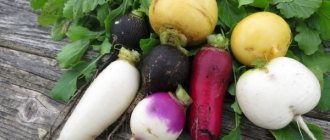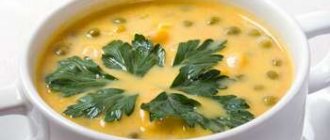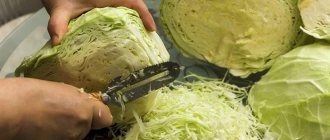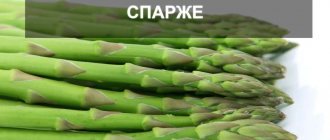Radish is a product that is especially useful in autumn and winter. The plant belongs to the cabbage family. Today it is widely used in cooking, dietetics, cosmetology and traditional medicine.
Both root vegetables and young foliage are eaten. The latter is added to salads and soups. Root vegetables are consumed raw, boiled and fried, and added to appetizers, okroshka, borscht, soups, meat and vegetable dishes.
- Salad
Chemical composition and beneficial properties
All types of radish contain the following beneficial elements:
- B vitamins , which help normalize metabolism and have a general strengthening effect;
- vitamin PP , which accelerates fat metabolism and tissue growth;
- vitamin C , which strengthens the immune system and helps normalize the functioning of all systems and organs;
- folic acid , which helps in the treatment of liver and kidney diseases;
- pantothenic acid , which promotes the normal functioning of the nervous and immune systems;
- fiber , which improves digestion and intestinal motility;
- mustard oil , which has a diuretic and choleretic effect and normalizes the functioning of the gastrointestinal tract;
- phytoncides – substances with antibacterial properties;
- lysozyme is a protein compound that is a powerful antiseptic. This component helps destroy pathogenic bacteria in the body and increases resistance to infections.
The beneficial properties of the vegetable for men, women and children are given in the table:
| Groups of people | Useful properties of radish and recommendations for use |
| Men | The vegetable is beneficial due to its ability to increase testosterone levels. However, this effect is insignificant, so the effect can only be achieved in combination with proper nutrition and a healthy lifestyle. For prostate pathologies, it is recommended to eat radish salad 2-3 times a week. The inflammatory process is significantly reduced. Eating raw vegetables eases hangover symptoms |
| Women | For women who experience irregularities in the menstrual cycle and scanty periods, root vegetable juice is useful, as it helps restore the cycle |
| Children | The vegetable strengthens the child's immunity. The root vegetable can be given starting from three years of age in small quantities. It is recommended to include daikon in your diet, which, due to its soft structure, does not irritate the gastric mucosa. It is permissible to give black and white radishes to a child, starting from the age of five, twice a week. A serving at one time should not exceed 50 grams |
Pregnant women are recommended to consume the root vegetable in small quantities. It can be added to salads made from other vegetables. But first you need to consult with the doctor who is caring for the pregnancy, since if you are predisposed to uterine hypertonicity, eating the vegetable can cause a miscarriage.
Eating a small amount of radish during breastfeeding is beneficial as it helps increase milk production. But if a child develops colic or flatulence, the vegetable should be excluded from the diet.
Main varieties of radish
Seed radish is an annual or biennial plant. Several varieties of this crop are known.
Black
Black radish
The vegetable is a round or oblong root vegetable with black skin and white flesh and has a pronounced bitter taste.
This variety takes first place in terms of the amount of useful substances. The product speeds up metabolism, strengthens the immune system, and is considered a natural antibiotic. Black radish juice is a choleretic agent.
Red
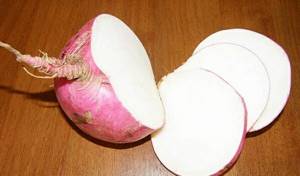
Red radish is a variety of black radish. This root vegetable has red skin and white flesh; it looks like a large radish.
Eating vegetables helps increase appetite. The root vegetable is an effective remedy for constipation and removes harmful substances from the body. The vegetable has a diuretic effect, therefore preventing the appearance of edema.
Margelanskaya (Chinese)
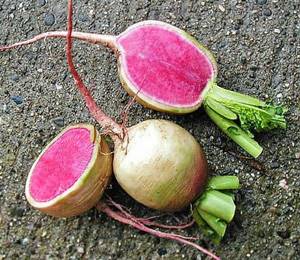
This is another variety of black radish. It is a round or oval root vegetable, the skin of which can have different shades: white, green, red, purple. This type of radish has white, red or purple flesh.
Chinese radish increases the secretion of gastric juice, and therefore helps increase appetite.
White
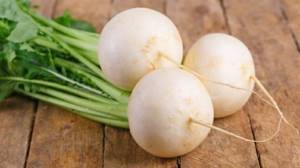
The vegetable has a very pungent taste. The color of the root crop is light green at the base, turning into white.
Radish is characterized by a pronounced antibacterial effect due to its high content of phytoncides. It strengthens the immune system and is considered an effective natural cough remedy.
Japanese

The plant is a variety of white radish. The vegetable is also called daikon or bailobo. It is distinguished by long (up to 50 cm) white roots and a sweet taste.
Radish has a short shelf life - no more than two weeks. Daikon has a diuretic effect and is widely used in folk medicine as a means to cleanse the body of toxins.
Green
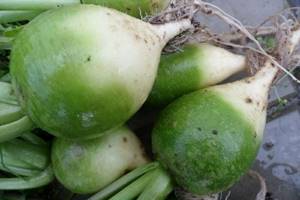
This variety has a pleasant, delicate taste with almost no bitterness. The root vegetable has an oblong shape with green skin and red flesh.
Green radish helps lower blood sugar levels, so it is useful for diabetes. The product contains a large amount of iron, it is recommended to use it for anemia.
Calories and nutritional value
BJU and the number of calories contained in various types of radish are given in the table:
| Type of radish | Proteins (per 100 g of product) | Fats (per 100 g of product) | Carbohydrates (per 100 g of product) | Calorie content (kcal per 100 g) |
| Black | 1,9 | 0,2 | 6,7 | 32 |
| Red | 1,2 | 0,1 | 3,4 | 20 |
| Margelanskaya | 1,2 | 0 | 4,1 | 21 |
| White | 1,4 | 0 | 4,1 | 21 |
| Green | 2 | 0,2 | 6,5 | 32 |
| Daikon | 1,2 | 0 | 4,1 | 21 |
Pickled
Pickling is not the most common way to process root vegetables, but it is an excellent way to preserve a supply of vitamins and nutrients for the winter. Green vegetables and Daikon can be used for the process. The calorie content of the finished product in the first case is 27 kcal per 100 grams, in the second - 20 kcal per the same amount, which means that both options may well be present on the table of someone losing weight.
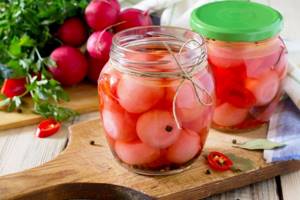
To pickle green radish, take a root weighing 500 grams. It is thoroughly washed and peeled. Chop using a Korean carrot knife. The brine is prepared in this way: add a quarter tablespoon of salt, half a tablespoon of sugar and vinegar to a glass of water. After mixing water, sugar and salt, the marinade is placed on the stove and brought to a boil. After removing from heat, add vinegar. The chopped vegetable is placed in a jar (when preparing for the winter, the jar must first be sterilized). Pour in hot marinade. Close the jar with a lid and leave for a day in a warm place. The finished product can be consumed separately or together with vegetable oil - sesame, olive, flaxseed. Of course, in this case the calorie content increases slightly.
To pickle Daikon, the washed and peeled vegetable is dried until pliable in the sun. The process takes about 2 weeks. After the Daikon reaches the required consistency, that is, it begins to bend slightly, it can be pickled. To do this, the root vegetable is fermented under pressure with salt for a couple of months. You can also add kelp, hot red pepper or sugar. The finished dish acquires a yellowish tint and has a specific, slightly spicy taste.
Criterias of choice
When choosing a product, you need to pay attention to the following characteristics:
- The vegetable should remain elastic and firm. A soft and limp root vegetable indicates long-term or improper storage, which results in the loss of its beneficial properties.
- The root crop should not have visible damage. They indicate the presence of pests and the likelihood that the radish is spoiled in the middle.
- The diameter of the black radish should be about 15 cm. With a smaller diameter, the vegetable is considered underripe, and with a larger diameter, it is considered overripe. In these cases, the content of nutrients in it is significantly lower.
Radish in folk medicine
In folk medicine, lettuce and root juice are most often used.
Salad

A healthy dish can be prepared using a fairly simple recipe:
- Grate the root vegetable on a coarse grater.
- Season with vegetable oil (olive oil is recommended).
- You can sprinkle the salad with finely chopped parsley and salt to taste.
Daily consumption of salad helps increase immunity and resistance to colds during epidemics. The dish is also useful for problems with the digestive system (it is an effective remedy for constipation), and has a diuretic and choleretic effect.
Radish with honey
The root vegetable is useful for diseases of the respiratory tract, as it has the ability to remove phlegm during a wet cough and have an enveloping effect during a dry one. For such pathologies, radish with honey is used (sometimes this remedy is called “radish honey”).
To prepare the product you should:
- Take a thoroughly washed root vegetable.
- Cut off the top and remove the core.
- Fill the resulting cavity halfway with honey.
- Close with the top “lid” and leave for 4 hours.
The resulting product should be taken once a day, one tablespoon at a time.
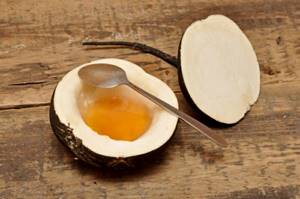
Radish with honey
If the symptoms of a cold - sore throat or cough - appear suddenly, it is recommended to start treatment with radish juice and honey.
Method of preparation and use of the product:
- Peel the vegetable, grate it on a coarse grater and squeeze out the juice.
- Add honey to the resulting juice in a 1:1 ratio.
- Mix the resulting mass thoroughly.
- Take a tablespoon of the product on an empty stomach three times a day.
Juice in its pure form is useful to drink for diseases of the cardiovascular system, as it dilutes blood clots and helps eliminate cholesterol plaques. It is recommended to take it three times a day, a quarter glass.
External use
For joint diseases, radish is used externally in the form of compresses.
It is necessary to wrap the grated root vegetable in gauze and apply it to the sore spot. Such compresses have a pain-relieving effect.
A little history
This root crop is considered originally Russian, although in fact it was first grown by the Egyptians. In particular, the Egyptians were the first to obtain oil from the seeds of this root crop. After them, people learned about radishes in Ancient Greece and Rome. If you believe modern history, the Romans treated this root crop very carefully, to the point that its seeds were worth their weight in gold.
Radish achieved such love because it contained many useful substances and helped maintain health.
It was especially appreciated in ancient times for its antimicrobial properties due to the high concentration of sulfur in the root crop [1]. Chemical composition of radish (per 100 g) [2]
| Calorie content | 36 kcal |
| Squirrels | 1.9 g |
| Fats | 0.2 g |
| Carbohydrates | 6.7 g |
| Organic acids | 0.1 g |
| Alimentary fiber | 2.1 g |
| Water | 88 g |
| Ash | 1 g |
| Vitamins | |
| Vitamin A | 3 mcg |
| Vitamin B1 | 0.03 mg |
| Vitamin B2 | 0.03 mg |
| Vitamin B5 | 0.18 mg |
| Vitamin B6 | 0.06 mg |
| Vitamin C | 29 mg |
| Vitamin E | 0.1 mg |
| Vitamin PP | 0.6 mg |
| Niacin | 0.3 mg |
| Macronutrients | |
| Potassium | 357 mg |
| Calcium | 35 mg |
| Magnesium | 22 mg |
| Sodium | 13 mg |
| Phosphorus | 26 mg |
| Microelements | |
| Iron | 1.2 mg |
The Greeks and Romans used it to treat the lungs, and also actively used it for kidney disease.
When this root vegetable came to Europe, terrible epidemics were raging there, and at that time radish mixed with honey was considered the best and universal remedy for treatment. They still use it now, but only for colds. In ancient times, a mixture of the juice of this root vegetable and honey also strengthened hair.
Regarding its use among the Slavs, traditional medicine has long noticed this important root vegetable. For a very long time it was used to treat diseases such as radiculitis, and compresses were made from it. This compress should be kept for several hours to relieve pain and combat exacerbations. Usually several sessions are enough. In addition, radish compress was used against colds and coughs. Similar compresses were also used to treat various wounds, including ulcers.
Recipes for weight loss
The benefits of the product for weight loss are due to the small amount of calories and the beneficial effect on the gastrointestinal tract. Root juice, salads, and cosmetics based on it are used.
To prepare a drink from black radish and honey you need:
- Rinse 10 kg of product thoroughly, grate and squeeze out the juice. The peel should not be removed.
- Pour 1 liter of honey into the resulting juice and mix thoroughly.
The resulting drink should be stored in the refrigerator and consumed a quarter glass before meals.
To prepare a salad for weight loss, you need the following ingredients:
- fresh carrots – 2 pcs.;
- apple (unsweetened) – 1 pc.;
- black radish root – 1 pc.;
- sour cream – 100 g.
Preparation:
- Grate carrots, radishes and apples or cut into thin strips.
- Add sour cream and stir. If desired, you can use yogurt, kefir or olive oil instead of sour cream.
- You can soften the taste of radish by adding 1 teaspoon of honey to the salad.
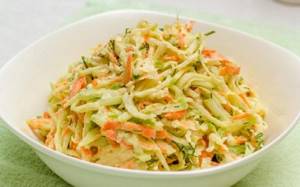
Black radish for weight loss can be used externally by making a cosmetic product from it. It also helps fight cellulite, stretch marks and flaking of the skin.
To prepare the product you need:
- Grate 2 root vegetables.
- Mix the resulting mass with three tablespoons of sea salt and one tablespoon of honey.
- Apply the finished mixture to the steamed skin of problem areas (thighs, abdomen, buttocks), massage and rinse after half an hour.
Application in cosmetology
This plant should not be used too often, as it is harsh on the skin. Recommended frequency: up to 3 times a week.
Before making masks, you need to cut the radish into slices and let it stand for some time in the open air. This is done to ensure that volatile compounds that can cause irritation are eliminated.
Cosmetics that are prepared from radish are given in the table:
| Means | Method of preparation and use | Impact |
| Whitening mask |
| The mask helps whiten the skin and get rid of freckles |
| Scrub for cleansing facial skin |
| The scrub helps cleanse pores and tighten them |
| Anti-dandruff remedy |
To achieve the desired effect, it is recommended to carry out 30 procedures | This mask helps get rid of dandruff and is useful for strengthening hair roots. |
Dried
Dried radish is no less popular seasoning than garlic or hot pepper. It can be used in the preparation of first and second courses, adding a special aroma and spice. In principle, you can buy a ready-made product in stores, but it is much healthier, especially when losing weight, to use your own seasoning. This contains the full range of benefits inherent in fresh vegetables: vitamins, macro- and microelements, unsaturated fatty acids.

If you wish, you can dry any type of plant, but black seems to be the most suitable for this. To begin with, the root is thoroughly washed and peeled, then cut into thin slices and laid out in one layer on a flat surface. Keep it outdoors away from sunlight for several days, and then put it in the oven. The required temperature is 60 degrees.
It’s just as easy to dry root vegetables in an electric dryer. In this case, no preparatory stage is required. The pulp is cut into thin slices and kept in a household appliance at a temperature of 60 degrees for 6 to 18 hours.
The finished product can be used in the form of slices or crushed using a coffee grinder. The seasoning should be stored in a glass container with a tight-fitting lid away from the sun and moisture.
The calorie content of the dried product is 271 kcal per 100 grams. The increase in calorie content in comparison with fresh root vegetables occurs due to the evaporation of moisture during the drying process and an increase in the amount of carbohydrates.
Harm and contraindications
Excessive consumption of radish may cause severe burning in the stomach and flatulence, as well as possible cardiac dysfunction.
Consumption of vegetables is contraindicated in the following cases:
- individual intolerance;
- stomach diseases (ulcers, gastritis);
- colitis;
- pancreatic diseases;
- gout;
- liver and kidney diseases;
- gallstones.
If contraindications are ignored, the harm from eating vegetables manifests itself in the exacerbation of these pathologies.
Even in the absence of serious diseases, before using radish for medicinal purposes, you should consult a doctor.

